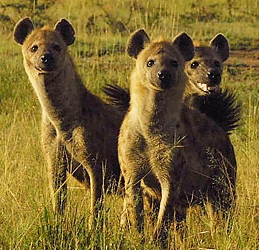 Brain imaging studies have revealed that when people think about other people, parts of the frontal cortex become active. Advocates of the social brain hypothesis say the frontal cortex expanded in our ancestors because natural selection favored social intelligence.
Brain imaging studies have revealed that when people think about other people, parts of the frontal cortex become active. Advocates of the social brain hypothesis say the frontal cortex expanded in our ancestors because natural selection favored social intelligence.
Most of the research on the social brain hypothesis has focused on primates. One reason for that bias, Dr. Holekamp said, is many scientists thought that no other animals were worth studying. “Primatologists have argued for years,” she said, “that primates are unique in terms of the complexity of their social lives.”
From her experience with hyenas, Dr. Holekamp had her doubts. So she began to run experiments on spotted hyenas similar to the ones run on primates. She would play recordings of hyenas, for example, to see if other hyenas recognized them individually. They did. She soon came to see the primates-only view of the social brain as deeply flawed. [complete article]
Editor’s Comment — The idea that social intelligence is the locus of human intelligence seems to me a rock solid assumption. Inventiveness, genius, talent and innovative creativity are invaluable to humanity but they percolate up way off on the social periphery. The stuff that makes us human is not so grand, and, so it appears, stuff that in some significant measure we share with hyenas. What concerns me though is that we seem to be on a social trajectory that may in evolutionary terms end up making us worse off than hyenas.
What does the atomization of social groups and the trend towards affinity groupings portend for our social intelligence? In other words, what becomes of our social intelligence if the only people we understand are the people who think the way we do? Is this not the point at which intelligence has stopped functioning? The point at which thought has become inherently circular?


All due respect to my favorite editor, I think that there are ” people who think the way we do” is a myth. There is as much conflict within the social group as there is within the family as there is within the individual.
The subject has been explored by the great psychoanalyst, Wilfred Bion, in his classic work, “Experiences in Groups”. His conclusion, if I have it right, is that the only a social group can be functional is 1) if it has a clearly defined task, and 2) if each member has a clearly defined role.
These are not stable conditions, and therefore the functionality of any group is
time sensitive.
We may also be aided in our efforts to be socially intelligent by the renderings of our failures by the great tragedians. However, too frequently these works have only a fleeting effect, since we can see clearly the tragic flaws of others, but are blind to our own.
The good news is that babies and little children are adorable, and do bring out the best in us even though they don’t “think the way we do.”
Intelligence grows when it has complications to master. Social relations are inherently complex, and grow more so, the more intelligently they are manipulated. When intelligence — or cognitive skill of any kind — becomes not just a tool but a prominent part of the social display itself, there is occasion for further hypertrophy, a feedback loop. With this, there is also a fundamental change in the dynamic — it’s no longer about the social per se, but about the skills themselves. This seems a plausible account of why social relations over the last few hundred thousand years might have provided a springboard for the explosion of human mental capacities, and why those capacities are no longer tied directly to their social origins.
But, to pick up on a theme introduced by the first commenter, all of this evolution took place in…. very small groups! Even today, the typical course of explosive development involves a small, intensely interacting group of highly competitive specialists, who validate and valorize (and bitterly despise) each other’s efforts. So, I suspect there’s little or no reason for pessimism. The human dynamic of unification and splitting is unstoppable, and it is that dynamic, not just one pole of it, that is facilitated by the technology we are using, now, to communicate our concord and our disagreement.
The social shift I was signaling without making explicit – a risky strategy of mine that leads some readers to think my comments are koans – was the shift that flowed from mobility. That shift has most commonly corresponded with the movement from the village to the city, but to define the trend in the broadest possible way it is the transition from relationships determined by physical proximity, to relations determined by affiliation. Obviously affiliations don’t end up producing people who truly all think alike, but there is a process of homogenization. We assume social veneers that mask our inner peasantry. Idiosyncrasies come to be viewed as social deficits. Normality is defined by similarity.
I know what you mean, but those of us who are idiosyncratic do not mind if we are viewed as socially challenged, because we don’t want to be part of the group. Sure we probably would feel more positively towards the world if it contained more odd balls, like us; but we can at least celebrate the fact that we exist!